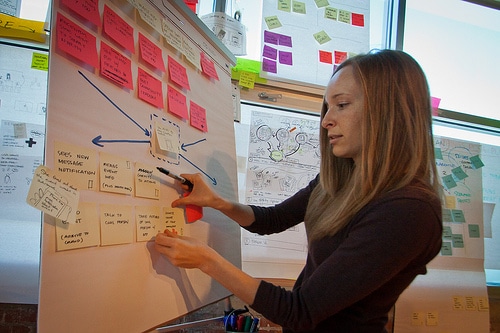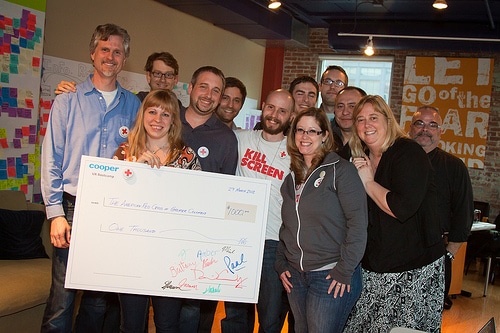As you may have heard, a bunch of us atoms went to Cooper UX Bootcamp Midwest a few weeks ago. As you also may have heard, it was a really great experience. Other people have done a great job of telling the story of what went on. You can read those stories here and here, so rather than reiterating what others have said very eloquently, I want to share four big things I learned at UX bootcamp.

1. Design collaboration should be messy.
At the beginning of UX bootcamp, we were each given a pad of paper, a pad of sticky notes, and a thick package of course materials. When we left, that stuff was all over the walls, the tables, and even the floor. As I left Sparkspace on Thursday, I was so glad I didn’t have to be the one to clean it up! All of the stickies and the sketches and the papers all over the place were the results of ideation and iteration and communication.
2. Share ideas, and don’t be tied to them.
As I participated in the conference, I was really astonished at how many really good ideas were being thrown around. It was great to be around such creative, smart people. I was also astonished with how many good ideas were expressed, and then passed over in favor of even better ideas. Design collaboration isn’t a contest to see who can have the best ideas — it’s about working together to create a great product. Be willing to share your ideas — good, great, bad, or otherwise — and then be willing to let them morph, evolve, or die. The photo above is a sketch Paul made of a branding concept, “Plus Us”. It centered around a core idea of “adding to the cause” (the red cross as a + sign). I thought it was a really interesting idea. While the “plus” language didn’t really make it into our final concept, the central idea of adding to the cause did. Paul’s plus idea transformed into something more robust, which we called a “Red Cross Moment”.

3. Wireframe a presentation using sticky notes.
On the last day of UX Bootcamp, we needed to pull together a slide deck to tell the story of the app that we designed. Amber, Micah, and I ran point on developing the narrative of the presentation, and we used sticky notes to decide how to organize the ideas we wanted to convey and what order to present them in. The sticky notes were a fast, flexible way to collaboratively wireframe a slide deck. We could easily rework and reposition ideas and we could see the flow of the whole presentation at once. After we were happy with the narrative, we could easily itemize the list of photos and other assets we would need to support it.

4. Zoom Out: tell stories; don’t talk about functionality.
I think this was one of the key ideas of the entire week. Instead of talking about “going to the profile page” or “using the donation screen”, we talked about our users’ daily lives and what the app would enable them to do. One of the ways we did this was to sketch some user scenarios (pictured above). Talking about it at this level does two key things: it helps designers/developers, users, and stakeholders come to a consensus on what a person will do with an application or website in their daily life. It also helps designers/developers and stakeholders develop a high amount of empathy for the user.

Atomic & friends won the design challenge, and Cooper donated $1000 in our name to the Red Cross. Here we are with a giant check.
UX Bootcamp was a really great experience, and I’m glad I got to share it with several of my colleagues. Because we were there together, we were able to participate in the day’s activities and then digest and discuss what we learned every evening and on the way home. By going as a group, we were able to develop a shared vocabulary of experiences, which we can now take and use on our projects at Atomic and share with the rest of the company.
For a neato photo montage of UX bootcamp, go here.

[…] month I write a blog post for the AO blog, and my most recent post was about how I went to UX Bootcamp last month with a bunch of my co-workers. Fun times. Other than that, I really can’t talk about what I […]